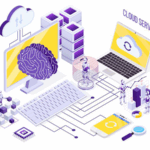Dominate 2025 with Next-Gen AI and ML Services for Future-Ready Growth
August 7, 2025 | 0 Comments
info@trickywebsolutions.com |
+1-225-276-2741
 USA
USA IN
IN
 SG
SG
 PT
PT
Based on reports, more than 50% of the companies never deployed a machine learning model. Eighty-five percent of the models never see production. The main reasons for this failure are a lack of expertise, inadequate change-management procedures, and a lack of automation systems. To tackle this challenge, it is important to integrate the MLOps with Python and .NET mechanisms, which will maximize the overall work efficiency and productivity. MLOps engineers need programming skills. Python and .NET are the most popular technologies used in machine learning. Since MLOps engineers collaborate with machine learning engineers and data scientists, knowledge of Python is important for efficient machine learning deployment .NET offers a powerful framework and libraries.
In this blog, we will guide you through how you can leverage MLOps with Python and .NET technologies and simplify your machine learning deployment. Moreover, before diving into the use of MLOPs with Python and .NET, we will first understand what is MLOps and why do we need MLOps.
MLOps, which stands for Machine Learning Operations for Production, contains some structured approaches to develop, release, and manage the machine learning model lifecycle. Such a system facilitates collaboration across multiple teams and offers an automated environment to monitor each stage of the machine learning model life cycle. MLOps strategies also enhance the scalability, security, and reliability of ML systems, leading to quicker machine learning deployment and better returns on ML projects.
Activities Included in MLOps are:
Experiment tracking: Recording experiments and outcomes to determine the most effective models
Model deployment: Moving models into production and enabling access for applications
Monitoring Models: Analyzing models to find any kind of issues or drops in performance
Model retraining: Model retraining refers to the process of updating the existing models with the latest information or data to improve the overall accuracy.
These are required to maintain the ML models’ flexibility, reliability, and manageability.
The set of core skills required in MLOps operations differs based on the specific demands of industry organizations. Some companies may require a unified platform capable of managing everything from data preprocessing to storage, modeling, deployment, and monitoring. Others might only need services related to model development, training, and deployment. In this section, we’ll cover the main strengths of MLOps.
Prior to leaping into advanced theories and actual use-case implementations, let’s go through a couple of examples:
Terraform – An Infrastructure as Code (IaaC) tool that manages cloud infrastructure by using configuration files.
Azure Databricks – A data analytics service that facilitates workspace development and effortless integration with ML libraries.
mlflow – An open-source framework built to handle every stage of the machine learning lifecycle.
MLOps has become an integral part for organizations as it plays a key role in handling the machine learning lifecycle and makes sure the ML models are being built, released, and managed successfully. This helps businesses analyze their data and get useful insights to make informed decisions. Without this, it can lead to several challenges for organizations. Here is why do we need MLOps for our organizations:
Handling processes manually often leads to more errors and mistakes; automating these processes can lead to enhanced performance and precision for ML models.
Implementing MLOps improves the overall scalability with its advanced, defined methods. As data grows in size, scaling up and down ML models manually becomes complex.
As the tasks and operations can be automated, it leads to saving a lot of time and improving efficiency.
Handling the process manually make it hard for team to collaborate effectively, MLOps make the collaboration efficient by breaking down silos between data scientists, software engineers, and operation teams.
MLOps offers a structured approach for your organization to reach data science objectives faster and with greater efficiency. Developers and managers can take a more strategic and flexible role in managing models. ML engineers can set up infrastructure using declarative configuration files, allowing projects to launch more seamlessly.
Improve the overall productivity and speed up the creation of ML models. For example, you can unify the development or experimentation environment. This allows ML engineers to initiate new projects, switch between tasks, and apply ML models across various applications. They can create uniform processes for rapid experimentation and training of models. Software engineering teams can work together and align throughout the ML software development lifecycle to improve efficiency.
MLOps enhances debugging and the oversight of models in production. For example, software engineers can observe model performance and replicate behavior for issue resolution. They can maintain version control of models in a centralized manner and select the appropriate version for various business scenarios.
Here is how Python and .NET improve the overall process of Machine learning deployment for an organization:
Python is considered one of the primary languages for training and developing machine learning models. It has many useful pre-built libraries, some of which include pandas, Pytorch, and TensorFlow. These libraries allow data scientists and software engineers to experiment with models and evaluate them effectively.
Apart from model training, Python finds extensive usage in data preprocessing, feature creation, experiment tracking, result visualization, and model verification. These aspects are critical to make the model reliable and production-ready.
With tools such as ML.NET and ASP.NET Core, .NET helps developers efficiently integrate ML models with high-performing APIs and enterprise applications. This ensures the deployed solutions meet business and operational demands.
.NET supports cross-platform deployment, allowing teams to deploy ML applications across Windows, Linux, and cloud environments. It also delivers strong runtime performance and better resource management in production environments.
While Python handles the flexibility of model development, .NET ensures robust and maintainable integration into software systems. This combination accelerates the end-to-end ML pipeline.
Python-trained models can be exported to interoperable formats such as ONNX (Open Neural Network Exchange) and then imported into .NET applications to run inferences. This makes deployment easier and enhances reusability.
By leveraging Python for development and .NET for deployment, teams benefit from faster iteration cycles, reduced development overhead, and more reliable machine learning solutions that are easier to monitor and maintain in production.
Recent Posts

Dominate 2025 with Next-Gen AI and ML Services for Future-Ready Growth
August 7, 2025 | 0 Comments

Scale Smarter in 2025: Why AI-Powered Cloud-Native Application Development is the Future
August 7, 2025 | 0 Comments

Your 2025 Guide to Next-Gen AI Development for Smarter Business Solutions
August 4, 2025 | 0 Comments

How to Create Cutting-Edge Blockchain Apps: A 2025 Development Guide
July 30, 2025 | 0 Comments

Boost Your Brand with Custom Mobile App Development Solutions
July 25, 2025 | 0 Comments

No Leads, No Sales? Here’s Why Your Website Isn’t Converting — and How to Fix It
July 24, 2025 | 0 Comments
Categories

We will zealously try to help you by providing technical support. We are open to inquiries or requests.
info@trickywebsolutions.com
1945 Brightside Drive, Baton Rouge, LA -70820
We are available for a friendly chat to discuss your business needs, no obligation.